battery INFINITI QX60 HYBRID 2015 Dismantling Guide
[x] Cancel search | Manufacturer: INFINITI, Model Year: 2015, Model line: QX60 HYBRID, Model: INFINITI QX60 HYBRID 2015Pages: 49, PDF Size: 3.21 MB
Page 29 of 49
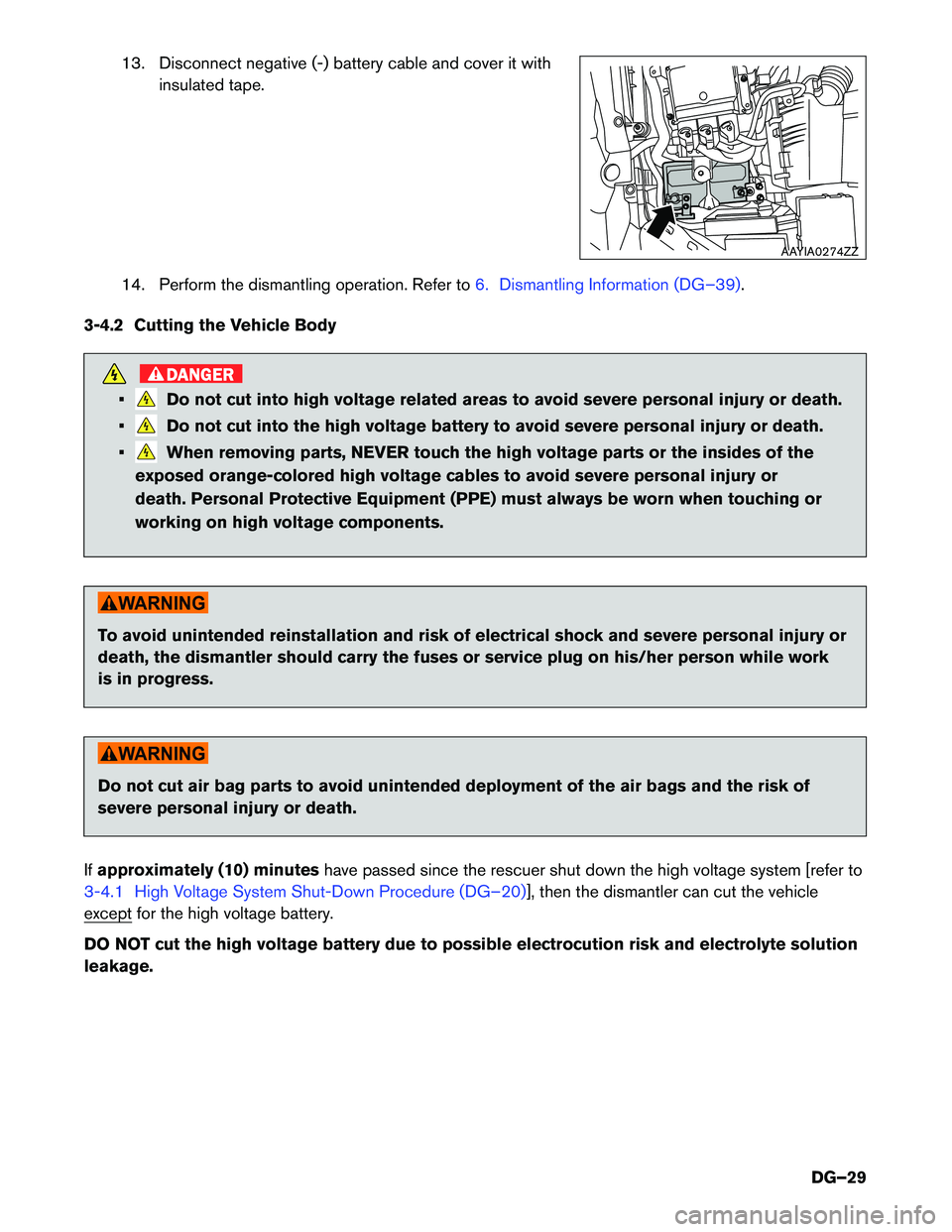
13. Disconnect negative (-) battery cable and cover it withinsulated tape.
14. Perform the dismantling operation. Refer to
6. Dismantling Information (DG–39).
3-4.2 Cutting the Vehicle Body
DANGER
•Do not cut into high voltage related areas to avoid severe personal injury or death.
•
Do not cut into the high voltage battery to avoid severe personal injury or death.
•
When removing parts, NEVER touch the high voltage parts or the insides of the
exposed orange-colored high voltage cables to avoid severe personal injury or
death. Personal Protective Equipment (PPE) must always be worn when touching or
working on high voltage components.
To avoid unintended reinstallation and risk of electrical shock and severe personal injury or
death, the dismantler should carry the fuses or service plug on his/her person while work
is in progress.
Do not cut air bag parts to avoid unintended deployment of the air bags and the risk of
severe personal injury or death.
If approximately (10) minutes have passed since the rescuer shut down the high voltage system [refer to
3-4.1 High Voltage System Shut-Down Procedure (DG–20)], then the dismantler can cut the vehicle
except for the high voltage battery.
DO NOT cut the high voltage battery due to possible electrocution risk and electrolyte solution leakage.
AAYIA0274ZZ
DG–29
Page 30 of 49
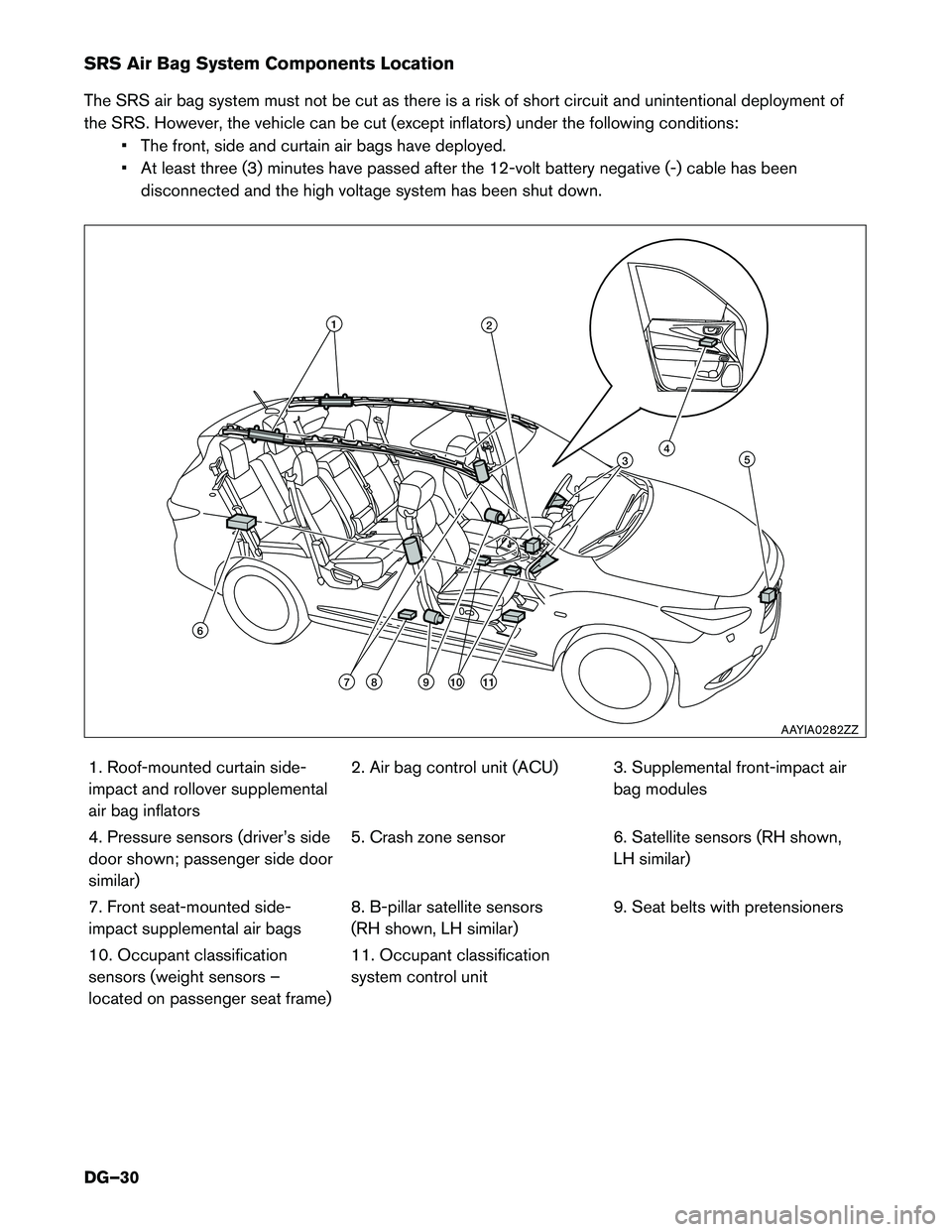
SRS Air Bag System Components Location
The SRS air bag system must not be cut as there is a risk of short circuit and unintentional deployment of
the SRS. However, the vehicle can be cut (except inflators) under the following conditions:• The front, side and curtain air bags have deployed.
• At least three (3) minutes have passed after the 12-volt battery negative (-) cable has beendisconnected and the high voltage system has been shut down.
1. Roof-mounted curtain side-
impact and rollover supplemental
air bag inflators 2. Air bag control unit (ACU) 3. Supplemental front-impact air
bag modules
4. Pressure sensors (driver’s side
door shown; passenger side doorsimilar) 5. Crash zone sensor 6. Satellite sensors (RH shown,
LH similar)
7. Front seat-mounted side-
impact supplemental air bags 8. B-pillar satellite sensors
(RH shown, LH similar)9. Seat belts with pretensioners
10. Occupant classification
sensors (weight sensors –
located on passenger seat frame) 11. Occupant classification
system control unit
12
345
1110987
6
AAYIA0282ZZ
DG–30
Page 31 of 49
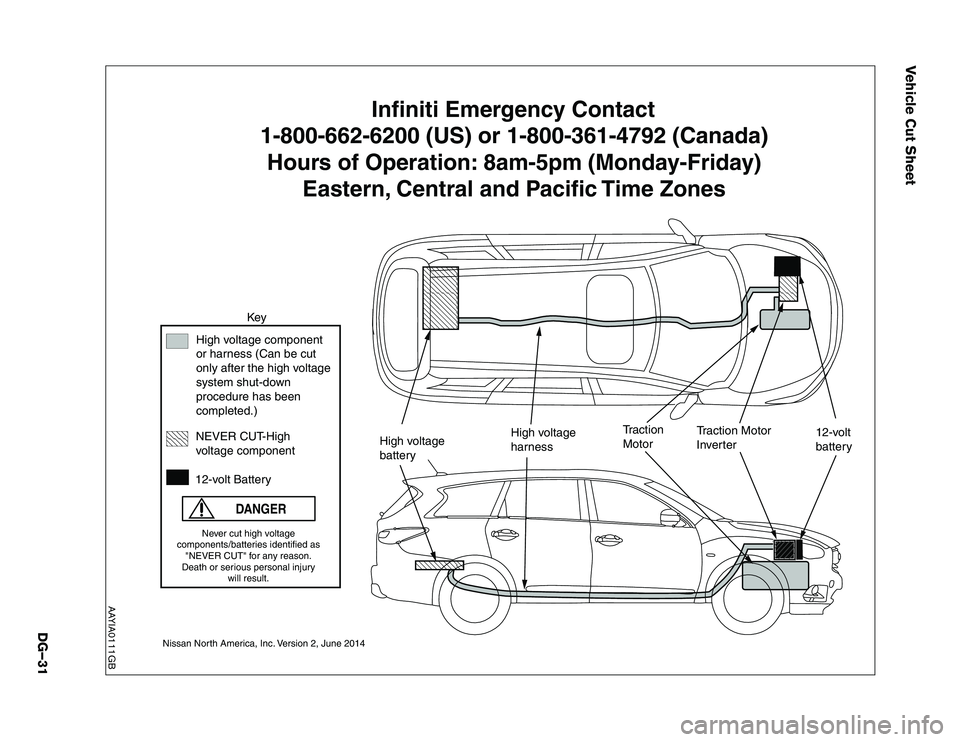
Vehicle Cut Sheet
���
���
��
��
�
�
���
��
��
1-800-662-6200 (US) or 1-800-361-4792 (Canada)
Hours of Operation: 8am-5pm (Monday-Friday)
Eastern, Central and Pacific Time Zones
High voltage component
or harness (Can be cut
only after the high voltage
system shut-down procedure has been completed.) Never cut high voltage
components/batteries identified as "NEVER CUT" for any reason.
Death or serious personal injury will result. Traction Motor
Traction Motor
Inverter
High voltage
harness
High voltage
battery 12-volt
battery
12-volt Battery
Key
DANGER
voltage component
Nissan North America, Inc. Version 2, June 2014 NEVER CUT-High Infiniti Emergency Contact
AAYIA0111GB
DG–31
Page 33 of 49
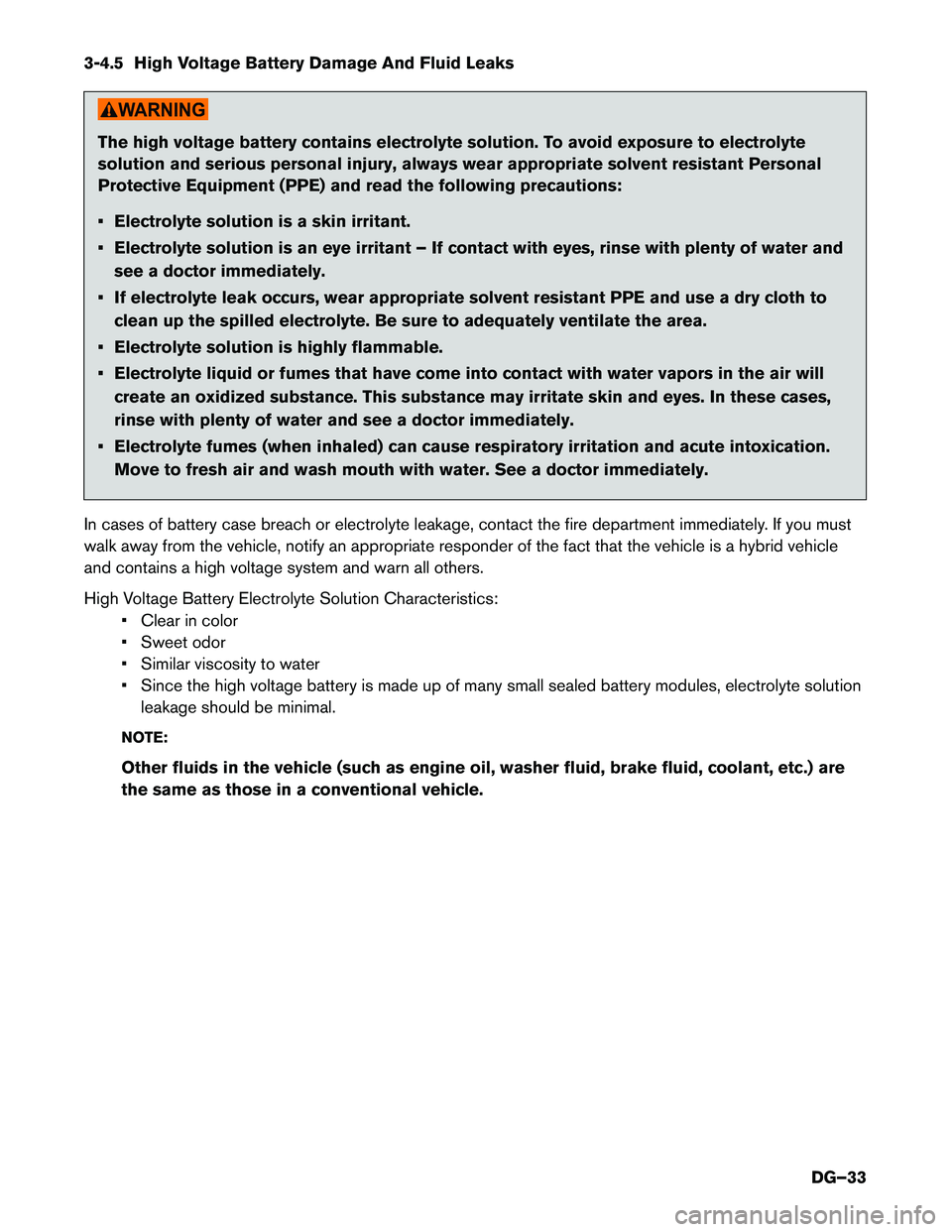
3-4.5 High Voltage Battery Damage And Fluid Leaks
The high voltage battery contains electrolyte solution. To avoid exposure to electrolyte
solution and serious personal injury, always wear appropriate solvent resistant Personal
Protective Equipment (PPE) and read the following precautions:
• Electrolyte solution is a skin irritant.
• Electrolyte solution is an eye irritant – If contact with eyes, rinse with plenty of water andsee a doctor immediately.
• If electrolyte leak occurs, wear appropriate solvent resistant PPE and use a dry cloth to clean up the spilled electrolyte. Be sure to adequately ventilate the area.
• Electrolyte solution is highly flammable.
• Electrolyte liquid or fumes that have come into contact with water vapors in the air will create an oxidized substance. This substance may irritate skin and eyes. In these cases,
rinse with plenty of water and see a doctor immediately.
• Electrolyte fumes (when inhaled) can cause respiratory irritation and acute intoxication. Move to fresh air and wash mouth with water. See a doctor immediately.
In cases of battery case breach or electrolyte leakage, contact the fire department immediately. If you must
walk away from the vehicle, notify an appropriate responder of the fact that the vehicle is a hybrid vehicle
and contains a high voltage system and warn all others.
High Voltage Battery Electrolyte Solution Characteristics: • Clear in color
• Sweet odor
• Similar viscosity to water
• Since the high voltage battery is made up of many small sealed battery modules, electrolyte solutionleakage should be minimal.
NOTE:
Other fluids in the vehicle (such as engine oil, washer fluid, brake fluid, coolant, etc.) are
the same as those in a conventional vehicle.
DG–33
Page 34 of 49
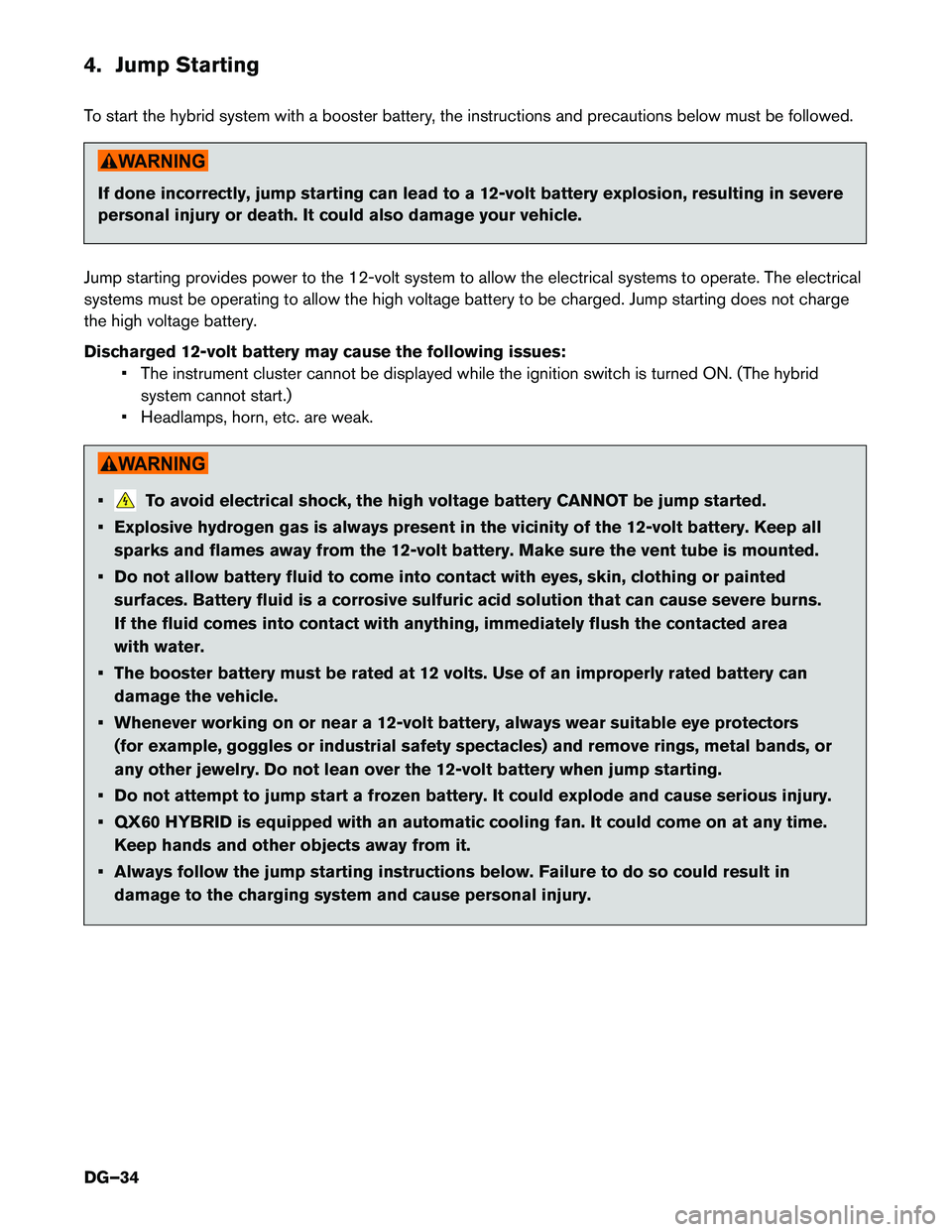
4. Jump Starting
To start the hybrid system with a booster battery, the instructions and precautions below must be followed.
If done incorrectly, jump starting can lead to a 12-volt battery explosion, resulting in severe
personal injury or death. It could also damage your vehicle.
Jump starting provides power to the 12-volt system to allow the electrical systems to operate. The electrical
systems must be operating to allow the high voltage battery to be charged. Jump starting does not charge
the high voltage battery.
Discharged 12-volt battery may cause the following issues: • The instrument cluster cannot be displayed while the ignition switch is turned ON. (The hybridsystem cannot start.)
• Headlamps, horn, etc. are weak.
•To avoid electrical shock, the high voltage battery CANNOT be jump started.
• Explosive hydrogen gas is always present in the vicinity of the 12-volt battery. Keep all sparks and flames away from the 12-volt battery. Make sure the vent tube is mounted.
• Do not allow battery fluid to come into contact with eyes, skin, clothing or painted surfaces. Battery fluid is a corrosive sulfuric acid solution that can cause severe burns.
If the fluid comes into contact with anything, immediately flush the contacted area
with water.
• The booster battery must be rated at 12 volts. Use of an improperly rated battery can damage the vehicle.
• Whenever working on or near a 12-volt battery, always wear suitable eye protectors (for example, goggles or industrial safety spectacles) and remove rings, metal bands, or
any other jewelry. Do not lean over the 12-volt battery when jump starting.
• Do not attempt to jump start a frozen battery. It could explode and cause serious injury.
• QX60 HYBRID is equipped with an automatic cooling fan. It could come on at any time. Keep hands and other objects away from it.
• Always follow the jump starting instructions below. Failure to do so could result in damage to the charging system and cause personal injury.
DG–34
Page 35 of 49
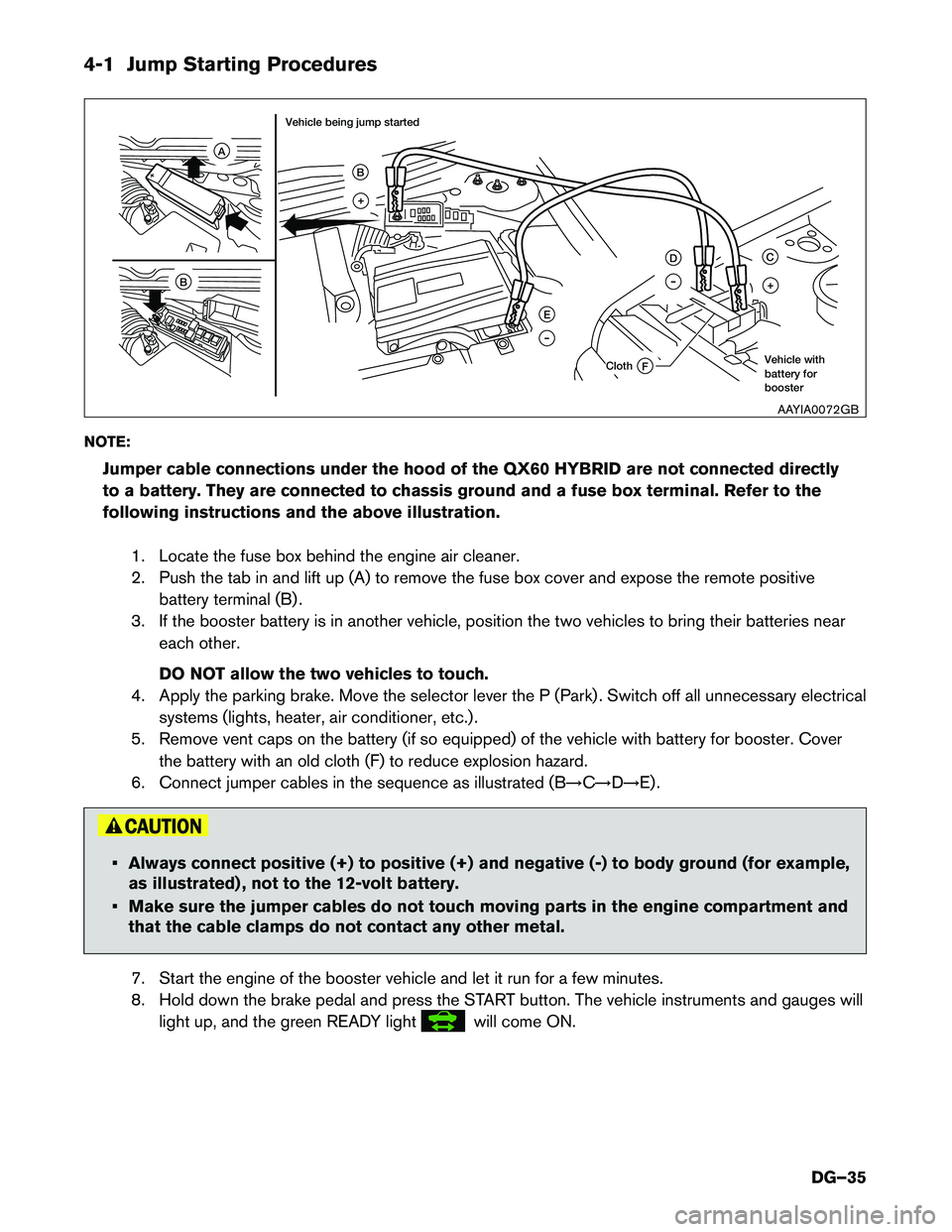
4-1 Jump Starting Procedures
NOTE:Jumper cable connections under the hood of the QX60 HYBRID are not connected directly
to a battery. They are connected to chassis ground and a fuse box terminal. Refer to the
following instructions and the above illustration.
1. Locate the fuse box behind the engine air cleaner.
2. Push the tab in and lift up (A) to remove the fuse box cover and expose the remote positivebattery terminal (B) .
3. If the booster battery is in another vehicle, position the two vehicles to bring their batteries near each other.
DO NOT allow the two vehicles to touch.
4. Apply the parking brake. Move the selector lever the P (Park) . Switch off all unnecessary electrical systems (lights, heater, air conditioner, etc.) .
5. Remove vent caps on the battery (if so equipped) of the vehicle with battery for booster. Cover the battery with an old cloth (F) to reduce explosion hazard.
6. Connect jumper cables in the sequence as illustrated (B �C� D� E) .
• Always connect positive (+) to positive (+) and negative (-) to body ground (for example,
as illustrated) , not to the 12-volt battery.
• Make sure the jumper cables do not touch moving parts in the engine compartment and that the cable clamps do not contact any other metal.
7. Start the engine of the booster vehicle and let it run for a few minutes.
8. Hold down the brake pedal and press the START button. The vehicle instruments and gauges will light up, and the green READY light
will come ON.
F
A
E
D
B
B
+
C
+
Cloth
Vehicle being jump started
Vehicle with battery for booster
AAYIA0072GB
DG–35
Page 36 of 49
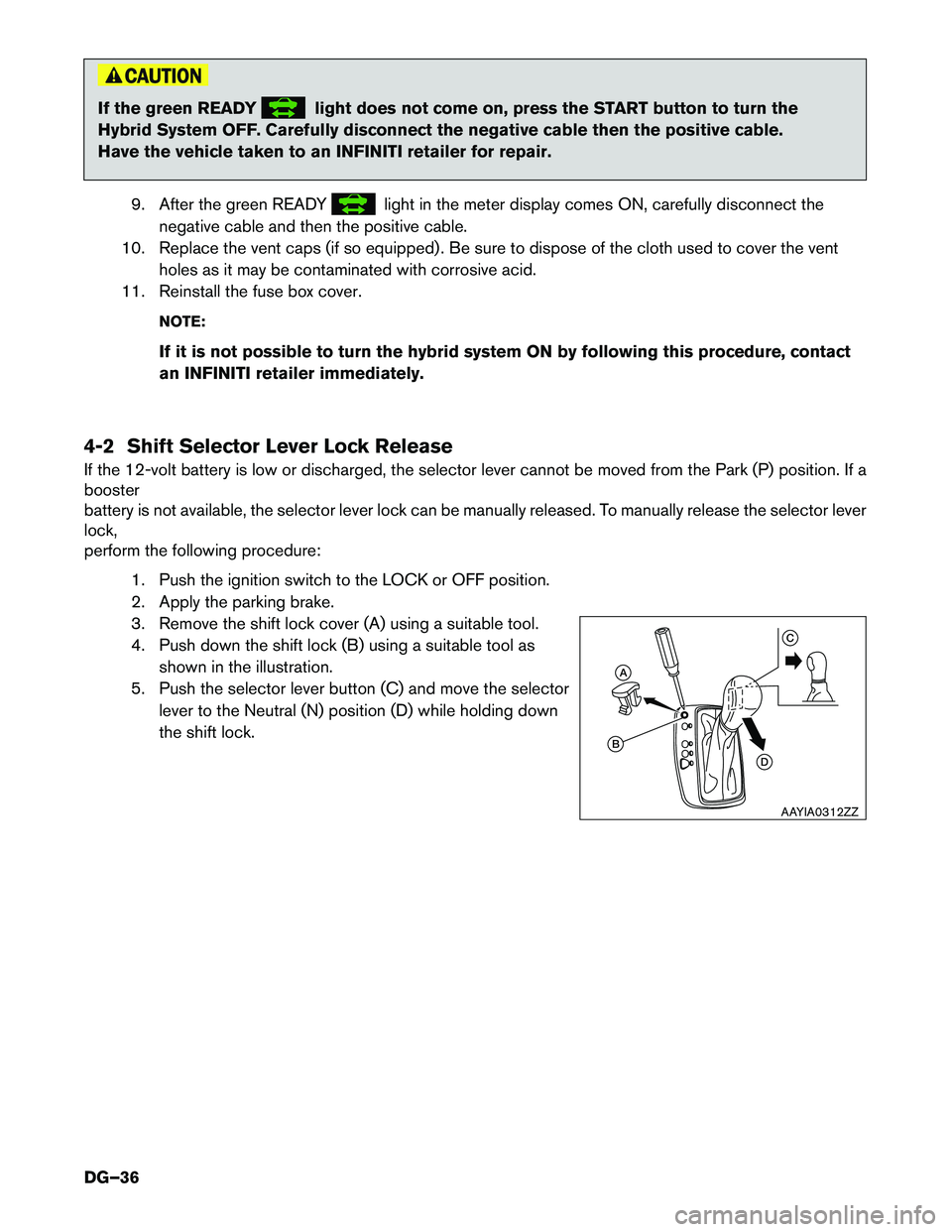
If the green READYlight does not come on, press the START button to turn the
Hybrid System OFF. Carefully disconnect the negative cable then the positive cable.
Have the vehicle taken to an INFINITI retailer for repair.
9. After the green READY
light in the meter display comes ON, carefully disconnect the
negative cable and then the positive cable.
10. Replace the vent caps (if so equipped) . Be sure to dispose of the cloth used to cover the vent holes as it may be contaminated with corrosive acid.
11. Reinstall the fuse box cover.
NOTE:
If it is not possible to turn the hybrid system ON by following this procedure, contact
an INFINITI retailer immediately.
4-2 Shift Selector Lever Lock Release
If the 12-volt battery is low or discharged, the selector lever cannot be moved from the Park (P) position. If a booster
battery is not available, the selector lever lock can be manually released. To manually release the selector leverlock,
perform the following procedure: 1. Push the ignition switch to the LOCK or OFF position.
2. Apply the parking brake.
3. Remove the shift lock cover (A) using a suitable tool.
4. Push down the shift lock (B) using a suitable tool asshown in the illustration.
5. Push the selector lever button (C) and move the selector lever to the Neutral (N) position (D) while holding down
the shift lock.
A
B
D
C
AAYIA0312ZZ
DG–36
Page 37 of 49
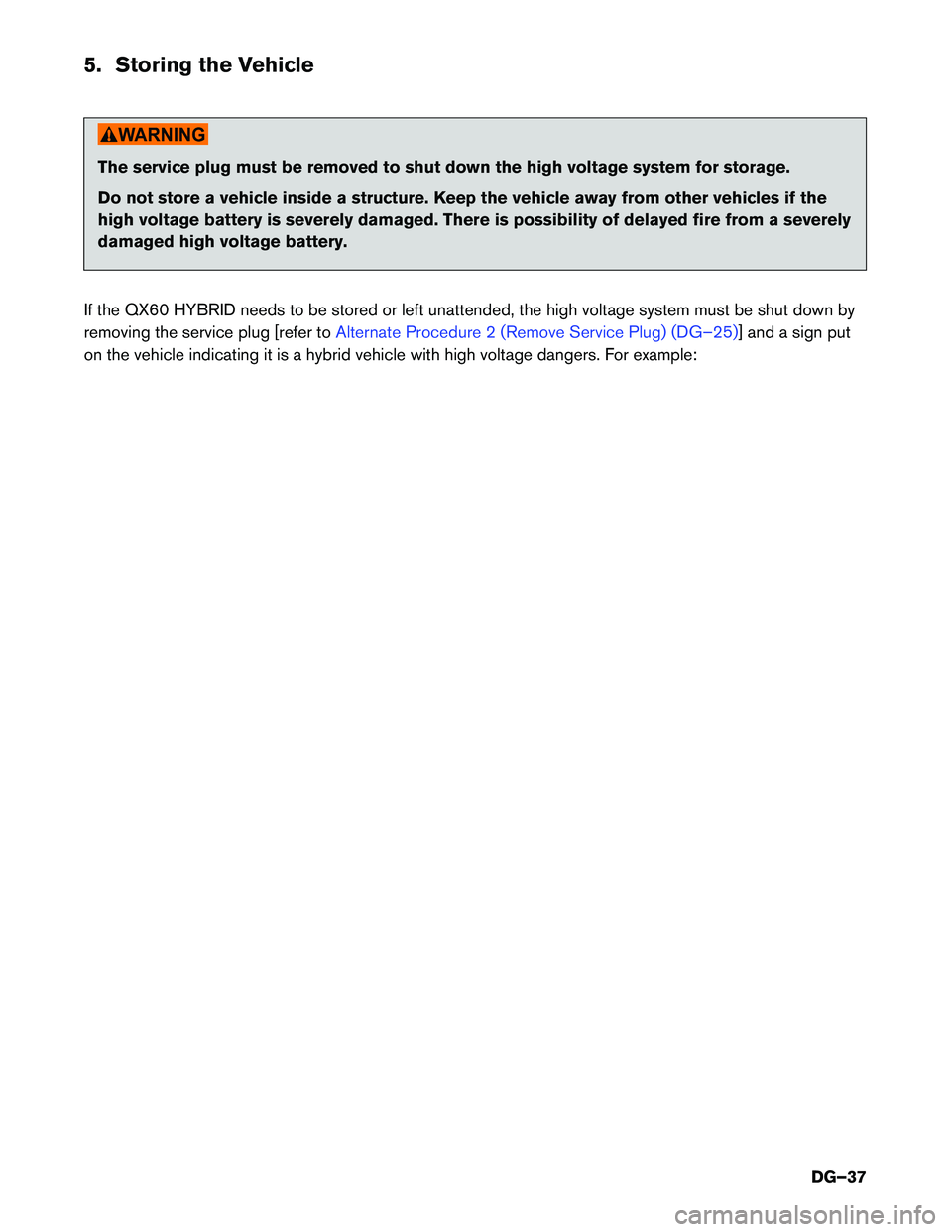
5. Storing the Vehicle
The service plug must be removed to shut down the high voltage system for storage.
Do not store a vehicle inside a structure. Keep the vehicle away from other vehicles if the
high voltage battery is severely damaged. There is possibility of delayed fire from a severely
damaged high voltage battery.
If the QX60 HYBRID needs to be stored or left unattended, the high voltage system must be shut down by
removing the service plug [refer to
Alternate Procedure 2 (Remove Service Plug) (DG–25)] and a sign put
on the vehicle indicating it is a hybrid vehicle with high voltage dangers. For example:
DG–37
Page 39 of 49
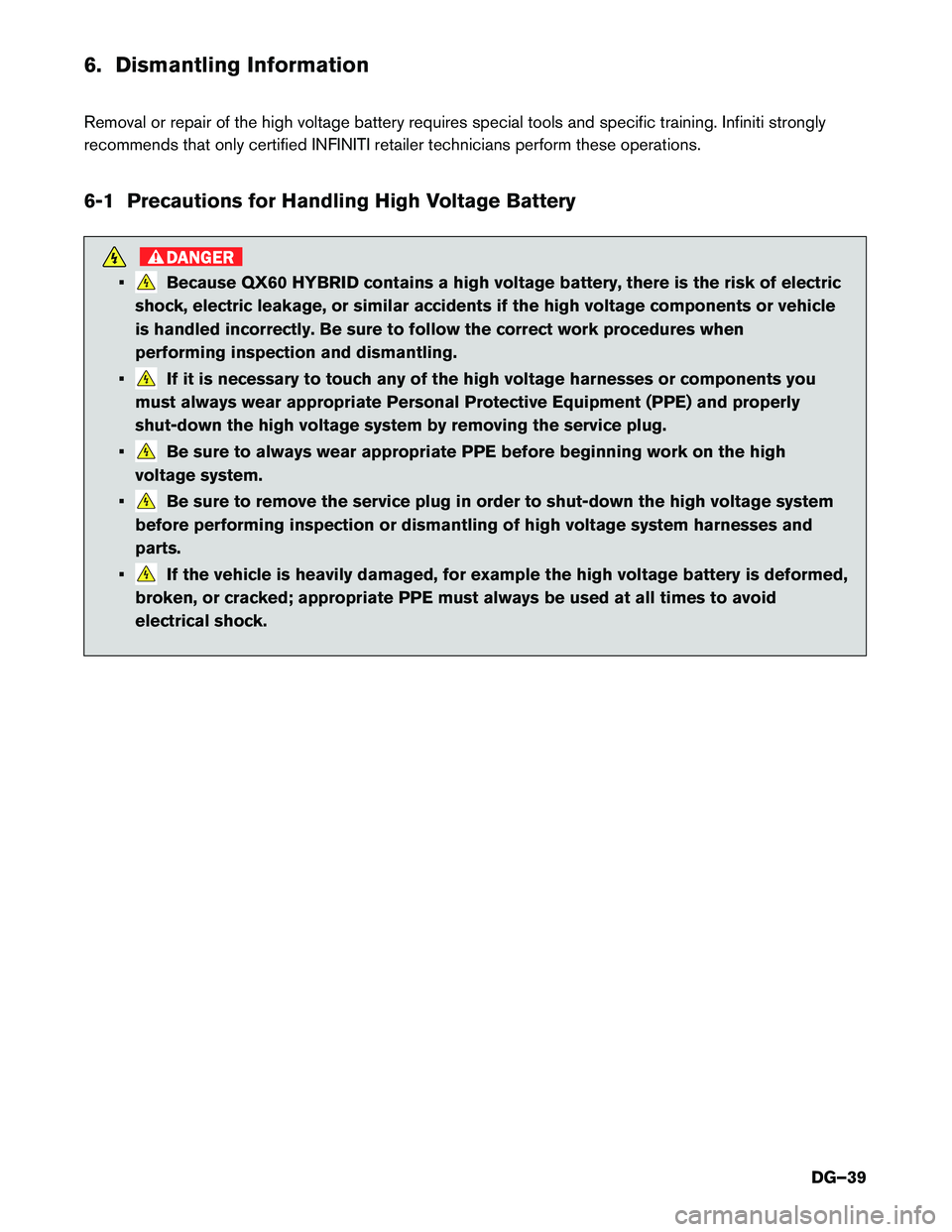
6. Dismantling Information
Removal or repair of the high voltage battery requires special tools and specific training. Infiniti strongly
recommends that only certified INFINITI retailer technicians perform these operations.
6-1 Precautions for Handling High Voltage Battery
DANGER
•Because QX60 HYBRID contains a high voltage battery, there is the risk of electric
shock, electric leakage, or similar accidents if the high voltage components or vehicle
is handled incorrectly. Be sure to follow the correct work procedures when
performing inspection and dismantling.
•
If it is necessary to touch any of the high voltage harnesses or components you
must always wear appropriate Personal Protective Equipment (PPE) and properly
shut-down the high voltage system by removing the service plug.
•
Be sure to always wear appropriate PPE before beginning work on the high
voltage system.
•
Be sure to remove the service plug in order to shut-down the high voltage system
before performing inspection or dismantling of high voltage system harnesses and parts.
•
If the vehicle is heavily damaged, for example the high voltage battery is deformed,
broken, or cracked; appropriate PPE must always be used at all times to avoid
electrical shock.
DG–39
Page 40 of 49
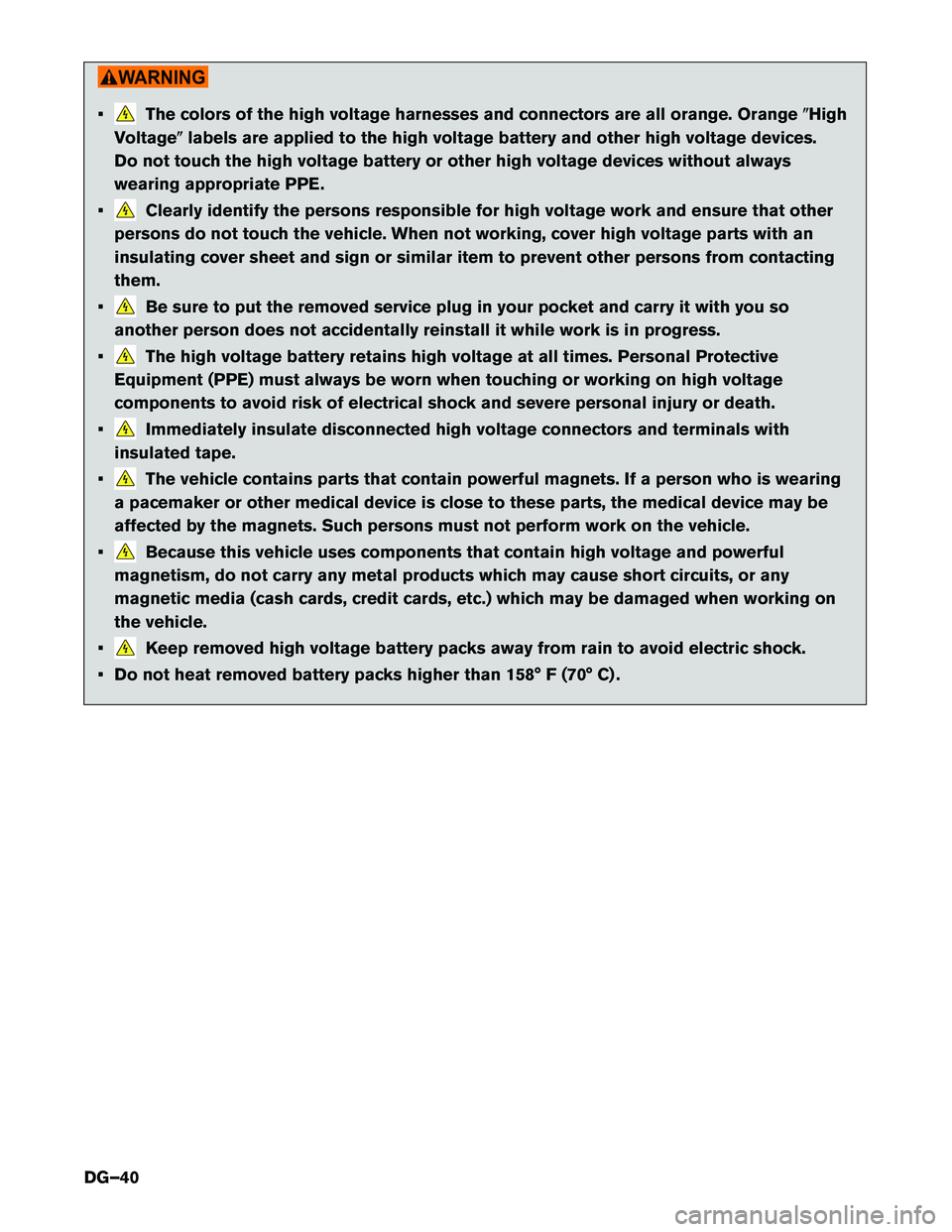
•The colors of the high voltage harnesses and connectors are all orange. Orange�High
Voltage �labels are applied to the high voltage battery and other high voltage devices.
Do not touch the high voltage battery or other high voltage devices without always
wearing appropriate PPE.
•
Clearly identify the persons responsible for high voltage work and ensure that other
persons do not touch the vehicle. When not working, cover high voltage parts with an
insulating cover sheet and sign or similar item to prevent other persons from contactingthem.
•
Be sure to put the removed service plug in your pocket and carry it with you so
another person does not accidentally reinstall it while work is in progress.
•
The high voltage battery retains high voltage at all times. Personal Protective
Equipment (PPE) must always be worn when touching or working on high voltage
components to avoid risk of electrical shock and severe personal injury or death.
•
Immediately insulate disconnected high voltage connectors and terminals with
insulated tape.
•
The vehicle contains parts that contain powerful magnets. If a person who is wearing
a pacemaker or other medical device is close to these parts, the medical device may be
affected by the magnets. Such persons must not perform work on the vehicle.
•
Because this vehicle uses components that contain high voltage and powerful
magnetism, do not carry any metal products which may cause short circuits, or any
magnetic media (cash cards, credit cards, etc.) which may be damaged when working on
the vehicle.
•
Keep removed high voltage battery packs away from rain to avoid electric shock.
• Do not heat removed battery packs higher than 158° F (70° C) .
DG–40